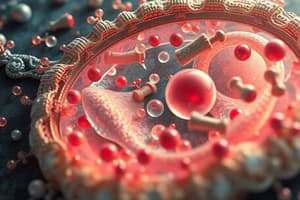Podcast
Questions and Answers
Which function of mitochondria is crucial for energy supply in cells?
Which function of mitochondria is crucial for energy supply in cells?
- Calcium homeostasis
- ATP production (correct)
- Regulation of metabolism
- Detoxification of ammonia
What is a primary function of the rough endoplasmic reticulum?
What is a primary function of the rough endoplasmic reticulum?
- Lipid synthesis
- Energy production
- Detoxification of ammonia
- Translation of mRNA (correct)
What distinguishes smooth endoplasmic reticulum from rough endoplasmic reticulum?
What distinguishes smooth endoplasmic reticulum from rough endoplasmic reticulum?
- Composition of lipid bilayers
- Presence of ribosomes (correct)
- Location in the cell
- Production of ATP
Which statement accurately describes the role of cholesterol in the cell membrane?
Which statement accurately describes the role of cholesterol in the cell membrane?
Which component of the mitochondria increases its surface area for ATP production?
Which component of the mitochondria increases its surface area for ATP production?
What is a key characteristic of the plasma membrane's selective permeability?
What is a key characteristic of the plasma membrane's selective permeability?
Which of the following functions does the endoplasmic reticulum NOT perform?
Which of the following functions does the endoplasmic reticulum NOT perform?
Which of these is NOT a role of the cell membrane?
Which of these is NOT a role of the cell membrane?
Which component of the cell membrane is primarily responsible for the bilayer structure?
Which component of the cell membrane is primarily responsible for the bilayer structure?
What is the role of integral proteins in the cell membrane?
What is the role of integral proteins in the cell membrane?
What type of protein is located on the inner or outer surface of the cell membrane?
What type of protein is located on the inner or outer surface of the cell membrane?
Which of the following components contributes to the fluidity of the cell membrane?
Which of the following components contributes to the fluidity of the cell membrane?
What percentage of the cell membrane is composed of proteins?
What percentage of the cell membrane is composed of proteins?
Which of the following correctly describes the arrangement of phospholipids in the cell membrane?
Which of the following correctly describes the arrangement of phospholipids in the cell membrane?
Which of the following molecules plays a crucial role in cell signaling and recognition?
Which of the following molecules plays a crucial role in cell signaling and recognition?
How do phospholipids within the cell membrane arrange themselves?
How do phospholipids within the cell membrane arrange themselves?
What primary function does the smooth endoplasmic reticulum (SER) perform in muscle cells?
What primary function does the smooth endoplasmic reticulum (SER) perform in muscle cells?
Which modification in the Golgi apparatus involves adding phosphate groups to proteins?
Which modification in the Golgi apparatus involves adding phosphate groups to proteins?
Which organelle is primarily involved in the detoxification process in liver cells?
Which organelle is primarily involved in the detoxification process in liver cells?
What is the primary characteristic of primary lysosomes?
What is the primary characteristic of primary lysosomes?
Which process in the Golgi apparatus involves the removal of mannose moieties?
Which process in the Golgi apparatus involves the removal of mannose moieties?
What primary role does the Golgi apparatus play concerning proteins synthesized from the rough endoplasmic reticulum (RER)?
What primary role does the Golgi apparatus play concerning proteins synthesized from the rough endoplasmic reticulum (RER)?
What is NOT a function of the smooth endoplasmic reticulum (SER)?
What is NOT a function of the smooth endoplasmic reticulum (SER)?
In the Golgi apparatus, glycosylation primarily involves what?
In the Golgi apparatus, glycosylation primarily involves what?
Flashcards are hidden until you start studying
Study Notes
Cell Membrane
- The cell membrane is composed of a phospholipid bilayer with hydrophilic heads and hydrophobic tails, forming a barrier for water-soluble substances.
- Cholesterol is found between phospholipid layers and contributes to membrane fluidity and stability.
- Proteins embedded in the membrane are crucial for transport, signaling, and structural support.
- Carbohydrates on the surface of the membrane are vital for cell recognition and interaction with external elements.
- The cell membrane allows for selective permeability, controlling the movement of substances in and out of the cell.
Mitochondria
- The powerhouse of the cell, mitochondria produce energy in the form of ATP.
- Composed of an outer membrane, an inner membrane folded into cristae, and a matrix containing enzymes and proteins.
- Mitochondria play a role in metabolism regulation, calcium homeostasis, apoptosis (programmed cell death), and detoxification of ammonia in liver cells.
Endoplasmic Reticulum
- A network of membrane-bound sacs (cisternae) and tubules involved in protein synthesis, lipid metabolism, and detoxification.
- Rough Endoplasmic Reticulum (RER) has ribosomes attached to its surface, involved in protein synthesis and transport to the Golgi apparatus.
- Smooth Endoplasmic Reticulum (SER) lacks ribosomes and is involved in lipid and steroid synthesis, detoxification, calcium storage, and carbohydrate metabolism.
Golgi Apparatus
- A stack of flattened membrane-bound sacs (cisternae) involved in protein modification, packaging, and secretion.
- It receives proteins from the RER and modifies them by glycosylation (adding sugars) or phosphorylation (adding phosphates).
- It packages proteins into transport vesicles for secretion or delivery to other organelles, including lysosomes.
Lysosome
- Membranous organelles originating from the Golgi apparatus containing hydrolytic enzymes for cellular digestion.
- Abundant in phagocytic cells.
- Primary lysosomes are newly formed from the Golgi and contain inactive enzymes.
- Lysosomes are crucial for breaking down waste products, cellular debris, and engulfed pathogens.
Studying That Suits You
Use AI to generate personalized quizzes and flashcards to suit your learning preferences.



